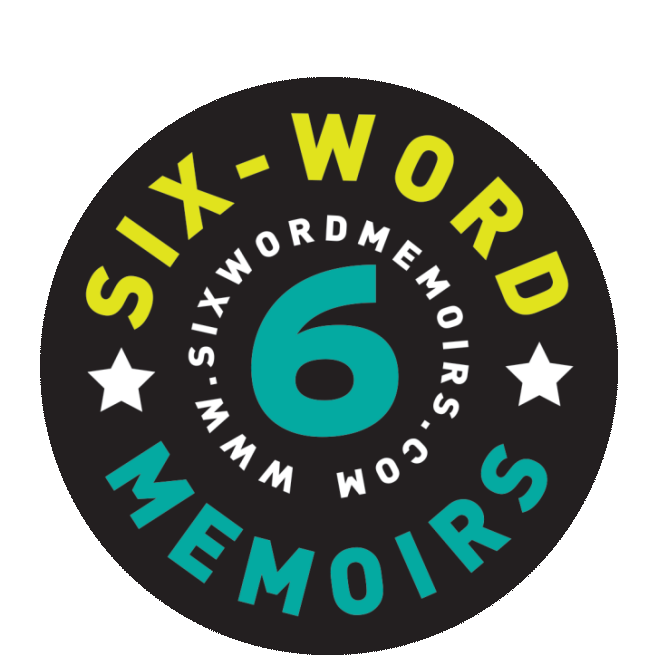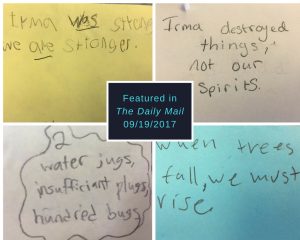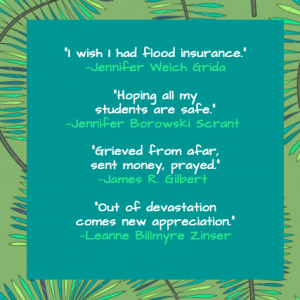When natural disasters strike, schools are impacted, too. How do you restore normalcy in the classroom when your region is dealing with recovery? Teacher Jon Mundorf recognized the power of Six Words to help students process their experiences outside of school and refocus on classroom learning.
Mundorf first discovered the six-word concept as a graduate student at University of Florida, and again during his doctoral studies. A seventh grade National Board-certified ELA teacher at P.K. Yonge Developmental Research School—a K-12 school at the University of Florida in Gainesville—he introduces Six Words into his classroom each year as an instant way to engage students. However, when Hurricane Irma approached Florida just a few weeks into the school year, Mundorf had not yet shared the concept with his students.
A State of Emergency had been declared for the entire state of Florida, which meant that schools statewide were closed effective September 7. When P.K. Yonge dismissed their students—who come from more than 30 towns and communities in the region—there was no expectation that Irma would threaten their area. Instead, the hurricane shifted course and the eye of the storm crossed their region; a terrifying event for everyone in the storm’s path.
As students and teachers returned to school the following week, Mundorf knew it was the ideal time to introduce the Six Words concept to his students—a transitional activity to address the storms’ impact and promote healing. “Emotions are such a critical component of cognition,” Mundorf explains. “If we’re not acknowledging and thinking about emotions, then it doesn’t matter much what happens next, because it won’t stick, it’s not lasting. Knowing that some of our students would’ve had really challenging hurricane experiences, I wanted to make sure they could name and address them, and then move forward.”
With 110 ELA students in 7th grade—five classes with 22 students each—it was particularly important in the aftermath of this traumatic event to engage every student: “As educators we have to consider a variety of methods to celebrate the voices and experiences of all students. Six-word stories becomes one of the methods that allows us to do that.” After Mundorf introduced the concept, students were given five minutes to write their memoirs. They then broke into small mixed-pair share groups and came together as a classroom to discuss their stories. Once all of the studentts had crafted six words about Irma, the Post-Its were displayed on Mundorf’s classroom door—more than 100 in total. The response was momentous, but nothing compared to the real-world response once Mundorf shared this classroom experience on social media.
Their Irma stories quickly went viral. P.K. Yonge’s English department first shared it in a tweet, then Mundorf shared it on his personal Facebook page. Minutes later, after many of his followers asked to share it with their networks, he made the post “public.” It quickly caught the attention of Love What Matters, who shared the story with their 7 million followers. Within days, it went global when their six-word stories were higlighted by The Daily Mail and Mundorf was featured in his Northeast Ohio hometown newspaper. When asked for his own Six-Word Memoir about the storm, Mundorf replied: “Irma raged, friends evacuated, fellowship ensued.”
Given the scope of Hurricane Irma on the heels of Hurricane Harvey, and the poignancy of these simple-yet-powerful Six-Word Memoirs, it’s no surprise that these meaningful, bit-sized stories generated such an overwhelming response. Mundorf emphasizes the importance of authentic connections: “When we share messages of hope that are genuine, people really connect with those. Who would’ve thought it that a tweet of four Post-It notes would grow into this? A few students said they would’ve worked a little harder on their initial stories if they’d realized this was going to be such a big deal,” he chuckles.
Mundorf, unsurprisingly, has a number of teachers among his followers. After this post, many planned to use Six-Word Memoirs with their students, and educator Debra Asmuth Fillingim proclaimed: “I love Six-Word Memoirs. I loved doing them with my students as well. No matter how young, their words are usually pretty profound.”
Giving every student a voice is a top priority for Mundorf: “Trying to understand other peoples’ stories gets us out of that space of looking for one correct answer but rather valuing the richness of the individuals. We have a sign on our door: ‘Your story matters. Tell your story.’ Giving people space and time to tell their story is so important. Once told, we must honor their stories—not getting into comparisons of whose story is better; rather, everyone’s story has value.”
When you consider Six-Word Memoir’s motto: “Everyone has a story. What’s yours™”—it’s clear that Six Words is a perfect fit in Jon Mundorf’s dynamic classroom, showcasing education and Six-Word Memoirs at their best.
Teachers! Since we first launched the Six-Word Memoir project, educators across the spectrum have found Six Words to be a terrific classroom assignment and catalyst for self-expression. At our Six in Schools section we celebrate students’ work from classrooms around the world. Contact us (concierge AT smithmag DOT net) if you would like a copy of our free teacher’s guide.
Post a Comment
You must be logged in to post a comment.





